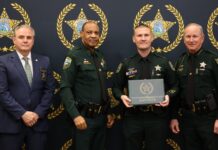Adams Key is one of nearly 50 islands within the Florida Keys archipelago located north of Key Largo. The island is tucked behind Elliott Key; Caesars Creek splashes against its southernmost shore.
The vast majority of Adams Key’s recorded history developed after the turn of the 20th century and involves the Cocolobo Cay Club and Carl Fisher, who has an interesting connection to South Florida and the Keys. Not only did he develop Miami Beach and dredge it up out of nothingness, but he also developed the world-famous Caribbean Club. In between those two ventures, he and some of his friends developed an exclusive club at Adams Key called the Cocolobo Cay Club.
A story about the club, published in the March 19, 1922 edition of the Miami Herald, shared a picturesque story about its inception. One day, Charles W. Kotcher, who made his fortune by being the largest individual operator of lumber retail in the United States, was motoring about Biscayne Bay in his cruiser Zigan. Kotcher had a couple of influential friends with him that day.
Kotcher motored down Caesar Creek, and when he came to Adams Key, he idled into a convenient harbor. According to the story, Kotcher looked first at the harbor and then the island and said, “What a marvelous spot for a fishing club. If only we could build a clubhouse on the summit of that knoll!”
His companions, Carl Fisher and James Snowden, agreed and “days later,” the lumber necessary to build a clubhouse arrived on the island, as did the presence of two dredges to create a channel deep enough to accommodate pleasure yachts. While the conversation, or one similar to it, sounds like a conversation between three friends out boating (with boat drinks likely involved), the rest of the story does not ring quite as true. It was considerably longer than a couple of days before the contractors showed up and began developing the island.
A “Notice” appeared in the Miami Herald on Oct. 2, 1916, that announced the application for a charter to form a not-for-profit social club called The Cocolobo Cay Club.
Article 1 of the application stated: “The name of the corporation shall be called ‘The Cocolobo Cay Club,’ and is said to be located on what is known as Adams Key.”
The “Notice” documented that ownership of the club, and perhaps the island, was split three ways. The club’s first president, Kotcher, had a 33% share. The club’s first vice president, Snowden, had a 33% share. Fisher, secretary and treasurer, had a 34% share in the operation.
As for the work done on the island, it was not until the summer of 1918 when J.L. Conklin finished working on projects for William Brickell and started building a seawall, docks and a clubhouse at Adams Key.
By the time the work was done, another “Notice” was posted in the Miami Herald. This time, the paperwork called for the dissolution of the Cocolobo Cay Club as a not-for-profit social club. It was signed by all five of the club’s members: Kotcher, Snowden, Fisher, W.E. Brown and Frank B. Shutts. It was not the end of the club, which was well-funded. Even as membership grew, one of the bragging rights for the club was that all of its members were millionaires.
In 1919, Brown was named the clubhouse manager, and he worked to improve the club and its facilities. One of the things he brought to the club was a radiophone. The reason it was such a good idea was relayed in the August 1923 edition of Motorboating magazine; the man who installed the device wrote the story.
The radiophone incorporated transmitting and receiving equipment in isolated areas, making communication between the two points possible. One station was located at Adams Key, and the “shore station was established 110 north of Miami” at Little River. At Adams Key, one of the things the radiophone did was improve service at the Cocolobo Cay Club.
Before the equipment was installed, members of the club and their guests would arrive on the island relatively unannounced. That proved problematic for the island’s staff, especially when two or more yachts would arrive around the same time expecting dinner. After the radiophone was installed, before a yacht left Miami or Miami Beach en route to the club, the Little River Station was notified, and, in turn, a call was made to the club to inform the steward what yacht was on its way, the expected time of its arrival and how many people were on the vessel.
The steward then knew how many meals needed to be prepped. Often, club members and their guests were expecting the steward, Oscar Rigaud, to prepare his famous spiny lobster — the special twist he added to the dish was missing from the article. Before the radiophone arrived, the arrival of several unexpected groups simultaneously led to long waits as the staff struggled to provide the expected level of service.
Because the club and the staff were no longer surprised by the number of guests showing up, the experience at the club was vastly improved. Another benefit of the radiophone was that it allowed guests who chose to stay overnight to get a message to those on the mainland who might be expecting them to show up at home.
The club continued to grow, both in membership and notoriety. Legendary Florida Keys guides took the club’s guests fishing, with four U.S. presidents counted among them. Next week, we will explore more of the Cocolobo Cay Club’s history, its guest list, what became of the club, and the hurricane that destroyed the last of its standing buildings.
























